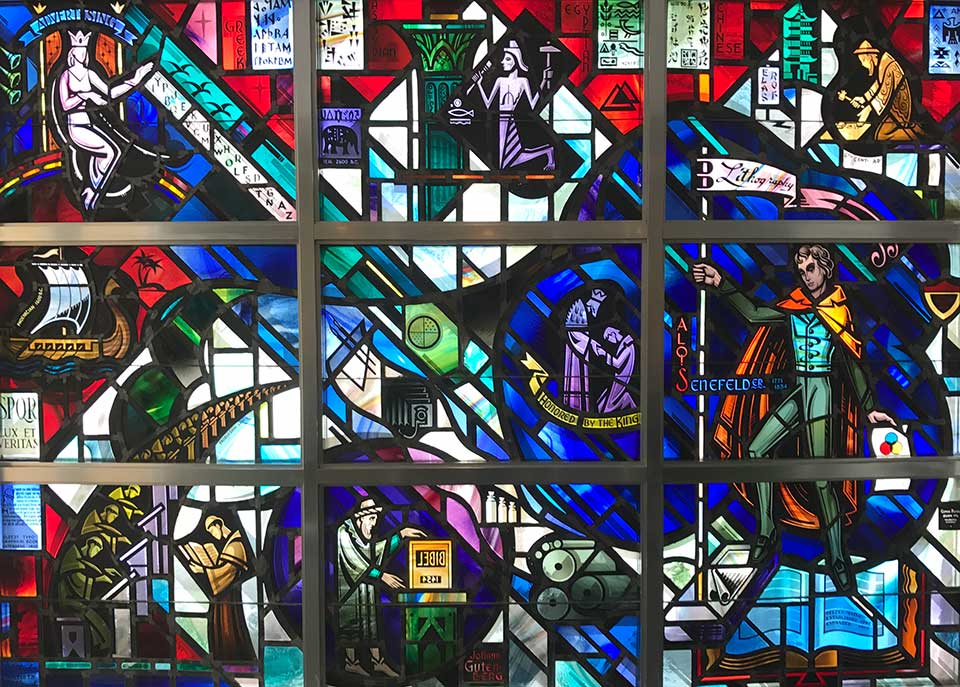Delzer’s Stained Glass, Explained.
State of the Art
Delzer’s shop and office has a reputation for an impeccable level of order and cleanliness. Work areas are tidy, equipment is diligently maintained and walkways are spotless.
And, while our office has undergone a full remodel since Delzer expanded operations over the course of its 70-year-long commitment to right, one thing stands the test of time in the midst of the modern finish – an original wall-to-wall stained glass application located in Delzer’s entrance vestibule.
History Buffs, Rejoice.
Clients, vendors, and visitors of Delzer often inquire about this unique piece. The short answer: it is a depiction of the history, impact, and world of print.
However, an original document from the 1950’s was recently exhumed from Delzer’s storage vault, detailing the symbolism behind the art. For those interested in local art and print history described in a tone parallel to the decade in which it created, this post is for you.
The History of the Printed World

The history of the printed word, rendered in stained glass, enhances an entire wall of the outer lobby in the modern, efficient Delzer-Marlow Lithograph Company building in Waukesha, Wisconsin. The window was designed and created by Al Timmler of the Conrad Pickel Studio.
The location of the stained glass window on the east wall was designed to capture the variations of light, resulting in most colorful patterns on floor and wall as the sunlight increases the brilliance of the glass. This changing light, artificial light at night and snow on the ground add new interest and beauty to the window, which stands as a fitting tribute to the craftsmen of the lithographic industry.

Dominating the panels on the right, Alois Senefelder, the 18th-century inventor of the lithographic process. Like a discoverer of old, he is shown planting his flag of lithography on one of the stones originally used in the process.
Surrounding him are designs telling of the honors bestowed on him by the King of Bavaria and the Royal Society of Arts of England in recognition of his important discovery.

Diagonal lines lead the eye to the upper left, where “Queen Advertising,” seated on a rainbow, casts the 26 letters of the alphabet to hovering birds (the readers) while trumpets signify the power of advertising.
The ancient Greek characters sharing the panel with Queen Advertising date from the year 2000 B.C.

Also in these diagonal lines, reading from top-left to bottom-center, are depicted the basic elements of lithographic craftsmen: the brushes of the artists, the camera and its resulting line and halftone negatives, the chemicals of the platemaker, and the various rollers on the presses.

Surrounding this central theme of lithography are designs representing the record of man’s written communications, beginning with the Chinese about 6000 B.C. Movable printed forms were used by them as early as the 6th century A.D. A touch of humor has been added with the small “For Sale” sign, shown in the reverse direction of the Chinese word character.
Tribute is also paid to our American heritage by including the North American Indian symbols in the upper right panel, which signify happiness, good luck, and peace.

The Egyptian, whose written history is set at 4241 B.C., is shown as he chisels his hieroglyphics into a huge column. Sharing this panel is a clay tablet of wedge-shaped cuneiform writing of an Assyrian business transaction, and a Babylonian seal.

The Phoenicians, the “traveling salesmen” of the age around 1600 B.C. shine on the middle left column. With their fast ships powered both by sail and oarsmen, Phoenicians journeyed far from their homes. Their written transactions appeared as far away as England.
The official emblem of the Roman Empire “SPQR” (Senate and People of Rome) and the popular “Light and Truth” phrase are shown as found in Roman monuments dating as far back as 400 B.C.
In the lower-left panel is illustrated the “production line” method of printing in the pre-Gutenberg era – many monks laboriously hand printing the Bible as one monk reads from a massive original book.

Bottom-center is a page from a book printed by Gutenberg. It is interesting to note that this page is certified as having been printed in the year 1450, which would make it four years older than his famous Gutenberg Bible (Bibel), which has always been proclaimed as his first work. Johann Gutenberg is acknowledged in the lower center panel, where he seems to be casting an envious eye at his more successful follower, Senefelder.


